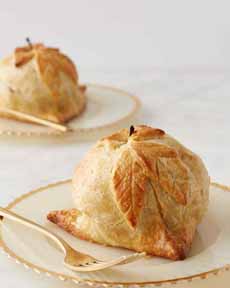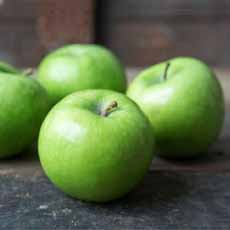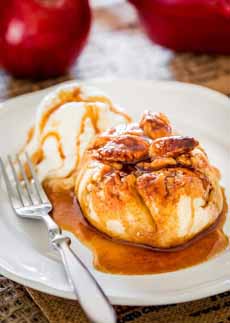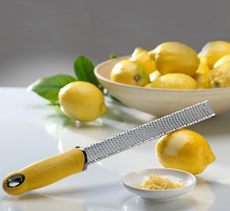RECIPE: Apple Dumplings For National Apple Dumpling Day
 [1] A classic apple dumpling, decorated with pastry scraps to look like an apple. Here’s the recipe from Martha Stewart.
|
Say the word “dumpling” and most people we know would think of Chinese and Japanese dumplings, two bites of pork, shrimp or vegetable stuffing in a noodle casing, fried or steamed.
But before the rise* of Asian restaurants in the U.S., most Americans thought of a dumpling as a sweet pastry wrapped around sliced apples or other fruit (photos #1 and #2). September 17th, National Apple Dumpling Day, celebrates that pastry, a different form for the ingredients of apple pie. If you’re in the mood, we have a recipe below. These delicious filled pastries are made by putting cored and peeled apples on a piece of dough, along with butter, cinnamon, lemon zest and sugar. Sometimes raisins or dried cranberries are added. What’s the difference between an apple dumpling and an apple turnover, you may ask? Largely, the shape:
APPLE DUMPLING HISTORY The word dumpling is first found in England around 1600, in the Norfolk dialect. It possibly derived from the Low German word for lump, dump. It described a small, usually globular, piece of boiled or steamed dough. Initially, dumplings were savory, filled with meat [source]. But the first dumplings—bite-size packets of filling wrapped in dough—are thought to have originated in the Eastern Han Dynasty of China, some 1,800 years ago. They were a way to serve meat in smaller, cheaper amounts. The first dumplings were thought to be filled with mutton, chilis and herbs, followed by other meats and seafood. Much later, in Europe, a dumpling was a ball of dough cooked and served in soup or stew. In Northern Europe, the dough was usually made with suet†, and was boiled, as in today’s Chicken And Dumplings. These pastries were also fried or baked. Other regions used other ingredients: potatoes (like Italian gnocchi, matzoh meal (Jewish matzoh balls) and flour dumplings that were often filled (Jewish kreplach, Polish pierogis, Russian pelmeni and numerous others). Dumplings likely emerged as a food of the poor: a cheaper way to satisfy hunger alongside a small piece of meat. The concept evolved into pastries filled with ground meat. Later, the word was ported to describe larger pastry dumplings filled with fruit, which became popular in Northern Europe. Apples, pears, plums and other fruits found their way into these sweet dumplings. Fruit dumplings were popularized in the U.S. by the Pennsylvania Dutch, who immigrated from Germany (Dutch is an American mis-spelling of their nationality, Deutsche). |
|
|
RECIPE: EASY APPLE DUMPLINGS
This recipe is adapted from Southern Living and uses refrigerated pie crusts as a hack. |
 [4] Granny Smith Apples (photo courtesy Good Eggs).
|
|
|
Preparation 1. COMBINE the sugar, water, cinnamon and nutmeg in a medium saucepan and bring to a boil over medium-high heat, stirring constantly. Reduce the heat and simmer for 10 minutes, stirring occasionally. 2. REMOVE from the heat and add the butter. Stir to combine and set the syrup aside. 3. COMBINE the apple filling ingredients in a small mixing bowl Mix with a fork until you have a crumb consistency. Set aside. 4. CUT each pie crust in half. Form each half into a ball and place on a lightly floured surface. Roll into 8-inch circles. 5. PEEL and core the apples. When you core, leave enough of a well to hold the filling. 6. PLACE each apple onto the center of each circle and fill the empty core with the crumb filling. Fold the dough over the apples, pinching at the top to seal. Place apples in a lightly greased 13″ x 9″ baking dish. Drizzle with the syrup. 7. BAKE at 375°F for 40-45 minutes. Serve warm with vanilla ice cream and other garnishes as desired. *The 1965 Immigration & Nationality Act enabled many more Asians to immigrate to the U.S., where they established restaurants. † Suet is a special type of fat, the hard white mass of fat surrounding the kidneys and loins of cattle (plus sheep and other animals). It has long been used in European cooking to make puddings, pastry and mincemeat. Suet has the the cleanest and mildest taste of all the animal’s fat. Fat from grass-fed beef fat is the best (although in the suet-loving past, all beef was grassfed!). Read more at: https://blog.thenibble.com/2018/07/10/tip-of-the-day-beef-tallow/
|
||





